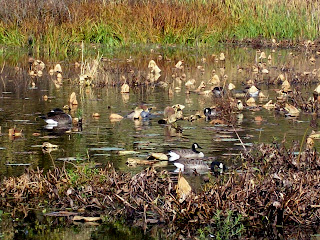Every time you hear the sound of a Canada Goose (
Branta canadensis) (probably the most common goose in your area if you live in the United States), you cannot deny the sense of wildness in that sound. Every time I have the opportunity to see these birds, I am in awe of their subtle beauty, loyalty to their partners and family groups, and their bugling cries that are uttered from the tight Vs they carve across the autumn sky. Having come so close to getting 300 species on my life list, I decided to scale it back a bit and look for those waterfowl that I admire and love. Featured below are some pictures I took of my trip this very afternoon. Hope you guys enjoy it. Happy birding ^_^.
 |
| Feeding in the shallows near the Concord River, this small family
signaled their presence to the other families of geese in the marsh with
their repeated "gor-unk" and "unka-unka-unka" cries. |
 |
| They definitely were enjoying the company of one another and were
feeding on whatever they could dredge up or reach with those long,
black-stockinged necks of theirs. |
 |
| The graceful and often adored form of an introduced Mute Swan appeared in the marsh. While the eBird checklist informs me that they appear 10% or more of the time at the Great Meadows Concord Unit; seeing one here really ruffles my feathers. Being an invasive species, I have largely negative views towards them, but I myself cannot deny the love some people have for these devoted and tenacious birds. |
 |
| This lovely trio came to investigate my intentions at the lock where
water flows from the marsh into the Concord River. As the picture shows,
these are probably wild migrants who, as I drew up my digital camera
for a few quick shots, started to turn away in order to put a comfortable
distance between myself and them. |
 |
| There's always a sentry to keep a watch for danger. This one
kept an eagle eye on me while its mate fed in the weedy shallows. I
admire their dedication and caution in regards to their partners. |
 |
A lone preening bird surrounded by dead or dying lotus plants. Another sign of the seasons, but with their death comes the
nutrients and space needed for a new generation of plants and seeds
needed to feed these visiting geese on their long migrations. |
 |
| Silhouettes on a mud bank. There may have been more ducks than geese here, but the geese were more engaging and raucous than their smaller, web footed cousins. They certainly drew more of my attention at the very least. |









Very nice blog.
ReplyDeleteIs the Canada goose the one typically associated with loonies (the coinage I mean)?
ReplyDeleteThe loonies refer to the Common Loon which is an unrelated water bird group.
ReplyDelete